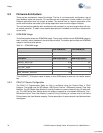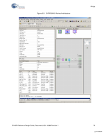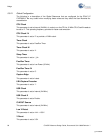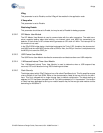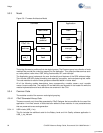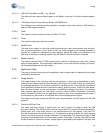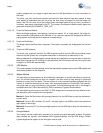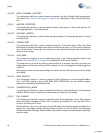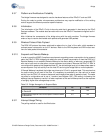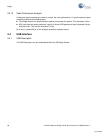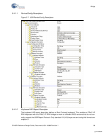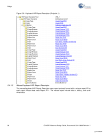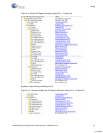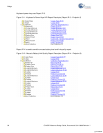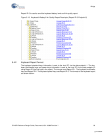
86 CY4672 Reference Design Guide, Document # 001-16968 Revision **
Bridge
5.3.6.10 BACK_CHANNEL_SUPPORT
This configuration definition is used to selectively compile in the Back Channel Data Support feature.
See section Back Channel Data Support on page 20 for a description of Back Channel Data Sup-
port.
5.3.6.11 MASTER_PROTOCOL
This configuration definition is used to select the Master radio protocol or Slave radio protocol. For
the bridge application, it should be defined.
5.3.6.12 PAYLOAD_LENGTH
This configuration definition is used to define the payload length. For the bridge application, it should
be defined as 8.
5.3.6.13 POWER_BIND
This configuration definition is used to selectively compile in Power Bind feature. When the Power
Bind feature is selected, the bridge enters the bind mode twice at power up. Each time the bridge will
stay in bind mode for 1.5 seconds, and if a device is in the bind mode during this time, the device will
be bound to this bridge.
5.3.6.14 KISS_BIND
This configuration definition is used to selectively compile in the Enhanced KissBind feature. See
section Enhanced KISSBind™ on page 18 for a description of Enhanced KissBind.
The bridge can be un-bound by holding the Bind button for 5 seconds. After being un-bound, the
bridge enters an infinite loop and the red LED is always on until it is unplugged from and plugged into
a host PC.
After being un-bound, the device bound flags are cleared, and the HIDs can be bound to this bridge
by KissBind.
5.3.6.15 RSSI_QUALIFY
This configuration definition is used to enable the RSSI qualification for the Enhanced KissBind.
Only if the RSSI reading is above KISS_BIND_RSSI_THRESHOLD, can the KissBind request/
response be accepted by the Bridge/Devices.
5.3.6.16 PROMISCUOUS_MODE
This configuration definition is used to enable the Promiscuous mode qualification for the Enhanced
KissBind. With this mode, multiple mice or keyboards can be bound to one bridge.
5.3.6.17 DAL_ENABLE
This configuration definition is used to enable Microsoft’s Direct Application Launch (DAL) feature.
When this feature is enabled, the DAL1 LED is turned on by holding the F11 key; the DAL2 LED is
turned on by holding the F12 key.
Direct Application Launch is a new feature that the Windows Vista operating system provides built-in
support, for a fast system startup experience. More information on this can be found on Microsoft’s
Windows Hardware Developer Central website (http://www.microsoft.com/whdc/system/vista/DirAp-
pLaunch.mspx).
[+] Feedback



